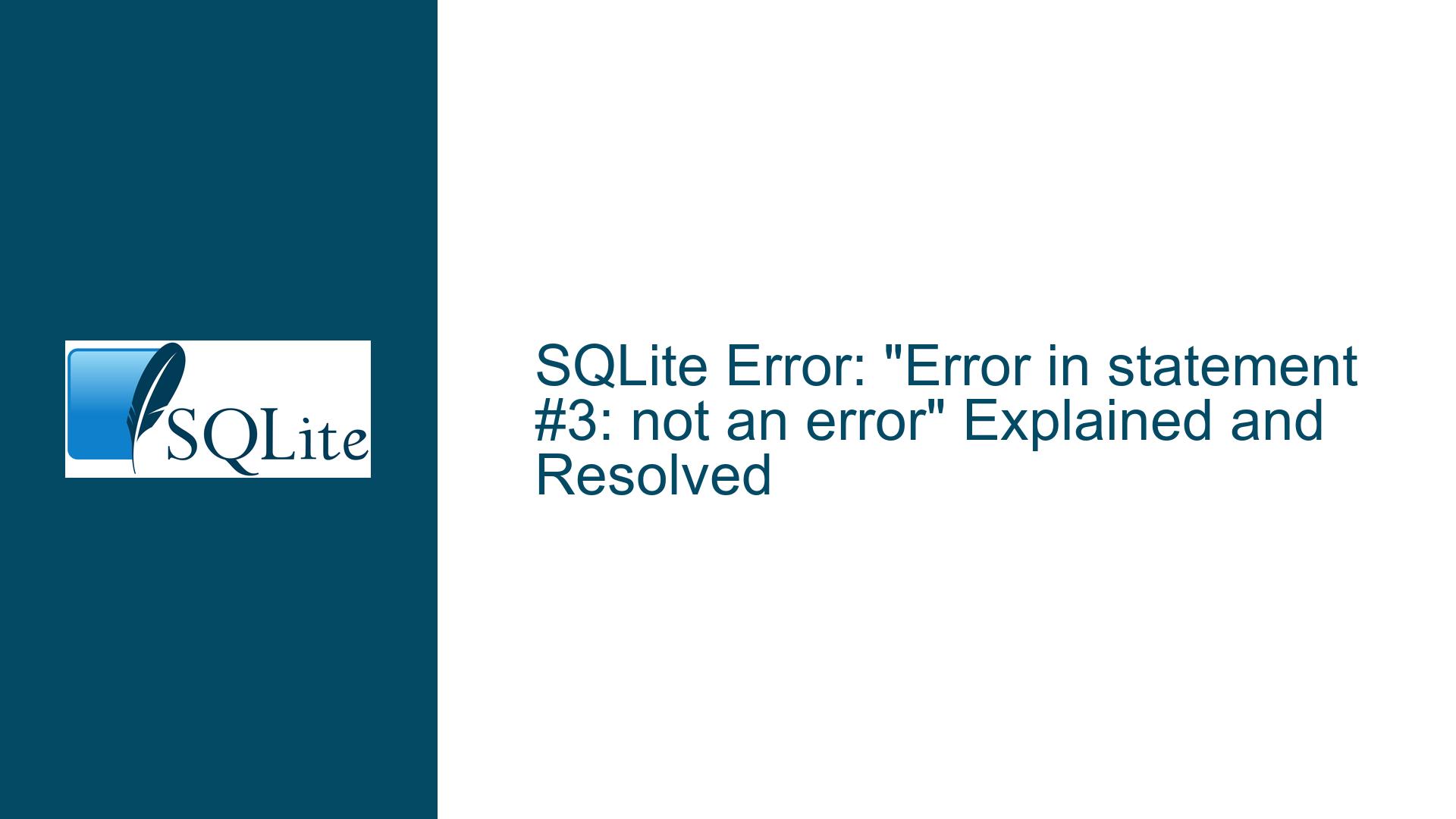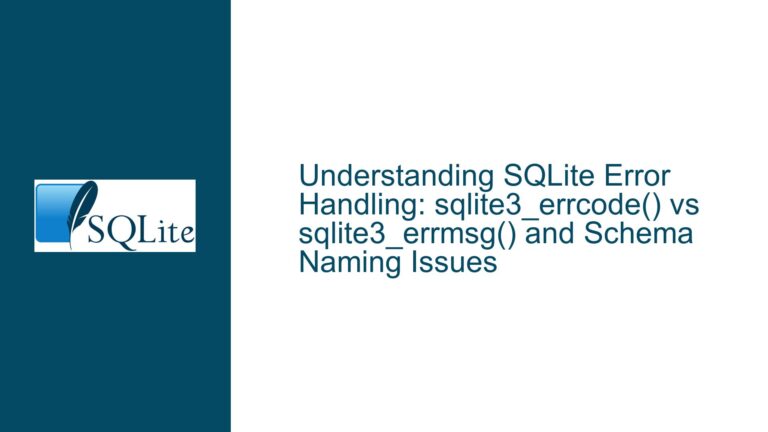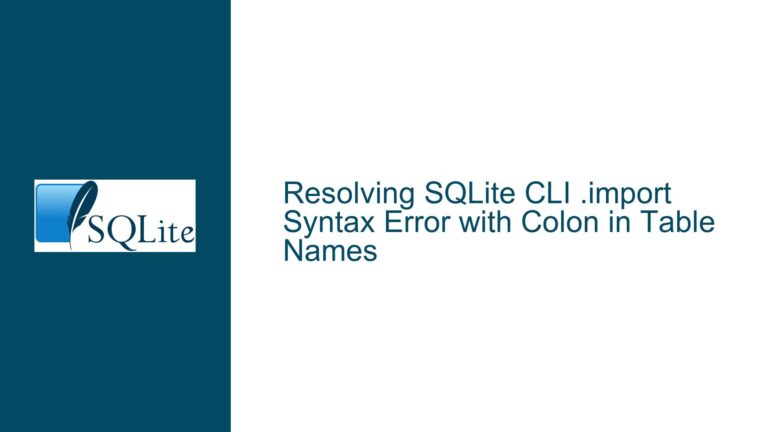SQLite Error: “Error in statement #3: not an error” Explained and Resolved
Error Message: "Error in statement #3: not an error"
The error message "Error importing data: Error in statement #3: not an error. Aborting execution and rolling back." is a perplexing issue that can arise when working with SQLite databases. At first glance, the message appears contradictory because it indicates an error while simultaneously stating that there is no error. This paradox can be particularly frustrating for developers and database administrators who are trying to import data or execute a series of SQL statements. The error message suggests that something went wrong during the execution of the third SQL statement in a batch, but the nature of the issue is not immediately clear. The message also indicates that SQLite has aborted the execution of the batch and is rolling back the transaction, which implies that the database is being restored to its state prior to the execution of the batch.
To understand this error message, it is essential to delve into the context in which it occurs. The error typically arises during the execution of a batch of SQL statements, often as part of a data import process. The batch may consist of multiple SQL statements, such as INSERT, UPDATE, or CREATE TABLE commands, which are executed sequentially. The error message specifically references "statement #3," indicating that the issue occurred during the execution of the third statement in the batch. However, the message does not provide any specific details about what went wrong, other than the cryptic "not an error" phrase.
One possible interpretation of the message is that the third statement in the batch did not produce an error in the traditional sense, but something about its execution caused SQLite to abort the entire batch and roll back the transaction. This could be due to a variety of factors, such as a constraint violation, a data type mismatch, or an issue with the database schema. The lack of specific information in the error message makes it difficult to diagnose the issue without further investigation.
Potential Causes: Constraint Violations and Data Type Mismatches
The error message "Error in statement #3: not an error" can be caused by several underlying issues, with the most common being constraint violations and data type mismatches. These issues can arise when the data being imported or manipulated does not conform to the constraints or data types defined in the database schema. Understanding these potential causes is crucial for diagnosing and resolving the issue.
Constraint Violations
Constraint violations occur when an SQL statement attempts to insert or update data in a way that violates one or more constraints defined in the database schema. Constraints are rules that enforce data integrity by restricting the values that can be stored in a table. Common types of constraints include PRIMARY KEY, UNIQUE, NOT NULL, and FOREIGN KEY constraints. For example, a PRIMARY KEY constraint ensures that each row in a table has a unique identifier, while a NOT NULL constraint ensures that a column cannot contain null values.
When a constraint violation occurs, SQLite typically raises an error and aborts the execution of the SQL statement that caused the violation. However, in some cases, the error message may not be as clear as expected, leading to messages like "not an error." This can happen if the violation is not detected until after the statement has been executed, or if the violation is related to a more complex constraint, such as a FOREIGN KEY constraint that involves multiple tables.
For example, consider a scenario where a batch of SQL statements includes an INSERT statement that attempts to insert a row with a duplicate primary key value. If the primary key constraint is violated, SQLite will raise an error and abort the execution of the batch. However, if the error is not immediately detected, the message "not an error" may be displayed, indicating that the issue is not a straightforward error but rather a constraint violation that requires further investigation.
Data Type Mismatches
Data type mismatches occur when the data being inserted or updated does not match the data type defined for the corresponding column in the database schema. SQLite is known for its flexible type system, which allows for a wide range of data types to be stored in a column, regardless of the declared type. However, this flexibility can sometimes lead to unexpected issues, particularly when importing data from external sources or executing complex SQL statements.
For example, consider a scenario where a column is defined as INTEGER, but the data being inserted is a string that cannot be converted to an integer. In this case, SQLite may attempt to perform an implicit type conversion, but if the conversion fails, it may raise an error and abort the execution of the batch. The error message "not an error" may be displayed if the type mismatch is not immediately detected or if the issue is related to a more complex data type conversion.
Another example of a data type mismatch could involve a TEXT column that is expected to store a date string in a specific format. If the data being inserted does not conform to the expected format, SQLite may raise an error and abort the execution of the batch. Again, the error message "not an error" may be displayed if the issue is not immediately detected or if the type mismatch is related to a more complex data type conversion.
Other Potential Causes
In addition to constraint violations and data type mismatches, there are several other potential causes of the error message "Error in statement #3: not an error." These include issues with the database schema, problems with the SQL statements themselves, and environmental factors such as file system errors or memory constraints.
Database Schema Issues
Issues with the database schema can also lead to the error message "Error in statement #3: not an error." For example, if the schema is not properly defined or if there are inconsistencies between the schema and the data being imported, SQLite may raise an error and abort the execution of the batch. This can happen if a table is missing a required column, if a column is defined with an incorrect data type, or if there are issues with indexes or triggers.
SQL Statement Issues
Problems with the SQL statements themselves can also cause the error message "Error in statement #3: not an error." For example, if a statement contains a syntax error or if it references a table or column that does not exist, SQLite may raise an error and abort the execution of the batch. Additionally, if a statement is too complex or if it involves a large amount of data, it may exceed SQLite’s internal limits, leading to an error and the subsequent rollback of the transaction.
Environmental Factors
Environmental factors such as file system errors or memory constraints can also contribute to the error message "Error in statement #3: not an error." For example, if the database file is stored on a corrupted or full file system, SQLite may encounter errors when attempting to read or write data. Similarly, if the system running SQLite is low on memory, it may be unable to execute the SQL statements, leading to an error and the rollback of the transaction.
Diagnosing and Resolving the Issue: A Step-by-Step Guide
Diagnosing and resolving the error message "Error in statement #3: not an error" requires a systematic approach that involves examining the database schema, reviewing the SQL statements, and considering environmental factors. The following step-by-step guide provides a detailed approach to identifying and resolving the issue.
Step 1: Review the Database Schema
The first step in diagnosing the issue is to review the database schema to ensure that it is properly defined and consistent with the data being imported or manipulated. This involves examining the structure of the tables, the data types of the columns, and the constraints that are in place.
Check Table Definitions
Begin by examining the definitions of the tables involved in the batch of SQL statements. Ensure that each table has the correct columns and that each column is defined with the appropriate data type. For example, if a column is expected to store integer values, ensure that it is defined as INTEGER and not as TEXT or another data type.
Verify Constraints
Next, verify that the constraints defined in the schema are appropriate for the data being imported or manipulated. For example, if a table has a PRIMARY KEY constraint, ensure that the data being inserted does not contain duplicate values for the primary key column. Similarly, if a table has a NOT NULL constraint, ensure that the data being inserted does not contain null values for the corresponding column.
Examine Indexes and Triggers
Finally, examine any indexes or triggers that are defined in the schema. Ensure that the indexes are properly defined and that they do not conflict with the data being imported or manipulated. Additionally, ensure that any triggers are functioning as expected and that they are not causing unexpected issues during the execution of the SQL statements.
Step 2: Review the SQL Statements
Once the database schema has been reviewed, the next step is to review the SQL statements in the batch to ensure that they are correct and consistent with the schema. This involves examining the syntax of the statements, the data being inserted or updated, and the order in which the statements are executed.
Check Syntax and References
Begin by checking the syntax of each SQL statement in the batch. Ensure that each statement is correctly formatted and that it does not contain any syntax errors. Additionally, ensure that each statement references the correct tables and columns and that there are no typos or other errors in the table or column names.
Validate Data
Next, validate the data being inserted or updated by each SQL statement. Ensure that the data conforms to the data types and constraints defined in the schema. For example, if a column is defined as INTEGER, ensure that the data being inserted is an integer and not a string or another data type. Similarly, if a column has a NOT NULL constraint, ensure that the data being inserted does not contain null values.
Review Execution Order
Finally, review the order in which the SQL statements are executed. Ensure that the statements are executed in the correct order and that there are no dependencies between statements that could lead to issues. For example, if a statement inserts data into a table that is referenced by a subsequent statement, ensure that the first statement is executed before the second statement.
Step 3: Consider Environmental Factors
After reviewing the database schema and the SQL statements, the next step is to consider environmental factors that could be contributing to the issue. This involves examining the file system, memory usage, and other factors that could affect the execution of the SQL statements.
Check File System
Begin by checking the file system on which the database file is stored. Ensure that the file system is not corrupted and that there is sufficient free space to store the database file and any temporary files that may be created during the execution of the SQL statements. Additionally, ensure that the file system permissions are correctly set and that SQLite has the necessary permissions to read and write to the database file.
Monitor Memory Usage
Next, monitor the memory usage of the system running SQLite. Ensure that there is sufficient memory available to execute the SQL statements and that the system is not running low on memory. If the system is low on memory, consider increasing the available memory or optimizing the SQL statements to reduce memory usage.
Review Logs and Error Messages
Finally, review any logs or error messages generated by SQLite or the operating system. Look for any additional information that could help diagnose the issue, such as file system errors, memory allocation failures, or other issues that could be contributing to the error message "Error in statement #3: not an error."
Step 4: Implement Fixes and Verify Resolution
Once the issue has been diagnosed, the final step is to implement the necessary fixes and verify that the issue has been resolved. This may involve modifying the database schema, adjusting the SQL statements, or addressing environmental factors.
Modify Database Schema
If the issue is related to the database schema, consider modifying the schema to address the issue. For example, if a constraint is causing the issue, consider relaxing the constraint or modifying the data to conform to the constraint. Similarly, if a data type mismatch is causing the issue, consider modifying the data type of the column or adjusting the data being inserted.
Adjust SQL Statements
If the issue is related to the SQL statements, consider adjusting the statements to address the issue. For example, if a syntax error is causing the issue, correct the syntax of the statement. Similarly, if a data type mismatch is causing the issue, adjust the data being inserted or updated to conform to the data type of the column.
Address Environmental Factors
If the issue is related to environmental factors, consider addressing those factors to resolve the issue. For example, if the file system is corrupted, consider repairing the file system or moving the database file to a different file system. Similarly, if the system is low on memory, consider increasing the available memory or optimizing the SQL statements to reduce memory usage.
Verify Resolution
Finally, verify that the issue has been resolved by re-executing the batch of SQL statements and checking for any errors. If the issue has been resolved, the batch should execute successfully without any errors or rollbacks. If the issue persists, consider revisiting the previous steps to identify any additional issues that may need to be addressed.
Conclusion
The error message "Error in statement #3: not an error" is a complex issue that can arise when working with SQLite databases. It is typically caused by constraint violations, data type mismatches, or other issues related to the database schema, SQL statements, or environmental factors. Diagnosing and resolving the issue requires a systematic approach that involves reviewing the database schema, examining the SQL statements, and considering environmental factors. By following the step-by-step guide outlined in this post, developers and database administrators can effectively diagnose and resolve the issue, ensuring that their SQLite databases function as intended.






